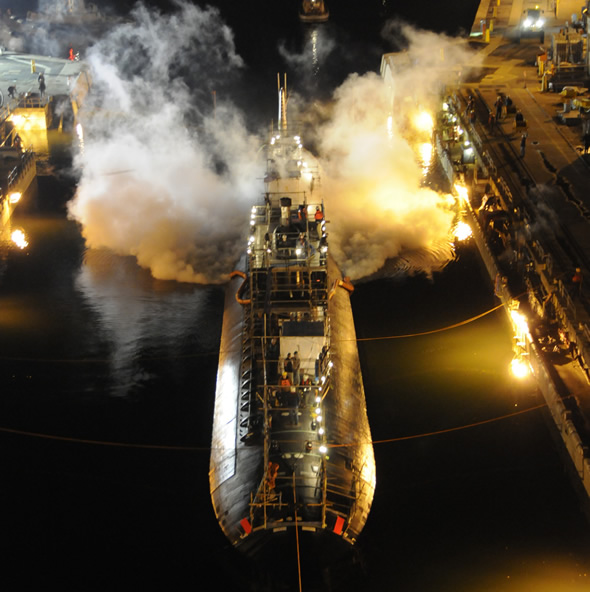
Initial US Navy estimates place the cost of repairing the nuclear-powered USS Miami attack submarine, damaged in a 23 May dry dock fire, at between $400 and $500 million. This appraisal was delivered to the US Congress in response to a congressional request and, Navy officials claim, is not a definitive cost projection but simply a preliminary estimate.
Navy representatives were also quick to point out that the estimate of repair costs does not constitute a firm decision to rebuild the ship. Foregoing repairs and scrapping the Miami may yet be determined to be the best option for the Navy.
When built the Los Angeles-class Miami cost $900 million, less than half of the $2 billion it now costs to build a new Virginia-class boat. The ship caught fire in Portsmouth Naval Shipyard while undergoing an extensive $200 million overhaul designed to keep her operational for another 10 years.
Navy experts are continuing their inspection of the ship with a primary focus on the Miami’s hull. Investigators are most concerned with determining if the ship’s steel hull is still seaworthy and capable of safely withstanding the immense stress of underwater operations to the same extent she was capable of performing before the fire.
Investigators have so far determined that the fire may have been caused by a vacuum cleaner being used by shipyard workers to clean their work areas. The vacuum cleaner was routinely stored in an unoccupied space. The fire is reported to have almost completely gutted the fore compartments of the Miami, but Navy officials said their investigation is ongoing and no specific recommendations regarding the ship’s future can be rendered until they have completed a thorough evaluation and analysis of the extent of the ship’s damage.
The compartments in the Miami that suffered damage include crew quarters, the torpedo room, and command and control spaces. The fire raged for almost twelve hours and injured seven firefighters. Miami’s nuclear reactor was not in operation at the time of the fire and the reactor spaces were sealed-off from danger almost as soon as the fire started.
At the time of the fire, the Miami had been in dry dock for about two months on a scheduled 20-month life-extension overhaul to upgrade engineering equipment and enhance the ship’s operational capabilities. Shipyards workers at the Portsmouth Naval Shipyard have returned to work to assist in clean-up operations and to lend a hand in damage assessment.
Repair costs could have been dramatically higher than estimated since many critical pieces of high-tech and expensive equipment were removed before the overhaul operation began. The fact that the stern of the ship escaped damage, particularly the reactor spaces, also contributed to lower repair estimates.
During a recent visit to the Portsmouth Shipyard, congressional delegates from Maine expressed hopes that the Miami would be salvaged and rebuilt. Senator Susan Collins, Maine Republican and a member of the Senate Armed Services Committee, indicated her hopes the Miami could be repaired in saying she was prepared “to work to help ensure the Navy has the necessary funds” to repair the ship.
A member of the US House Armed Services Committee, Maine Democrat Representative Chellie Pingree, also expressed her optimism that “the Navy will be able to come up with the money” needed to repair the Miami. Representative Pingree said, following her tour of the Miami, that shipyard workers gave her “every indication” in their comments “that they could fix the Miami.”
Should Navy investigators determine the Miami cannot be salvaged, it would be a severe loss for the Navy’s submarine force. The number of operational attack submarines is schedule to decline in the next few years as older boats are retired faster than they can be replaced. The Navy’s latest budget request asked for funding for only nine of the newest Virginia-class boats instead of ten in the next five years, a construction schedule that has caused considerable ire among some congressional representatives.
With most critical systems undamaged and the reactor and propulsion system unaffected, hopes are high that vital repairs can be completed and will add only an additional four- to six-month’s time to the Miami’s scheduled overhaul. The Navy is anxious to provide Congress with cost estimates as quickly as possible with an eye towards including the costs into the Overseas Contingency Operations (OCO) portion of the pending defense budget. The more quickly funding is approved for repairs, the more quickly the Miami can be placed back into operation.
With the Miami laid up, the Navy will have to develop a plan to find some means of performing her scheduled deployments. Should the Miami be scrapped, there is no immediate replacement available to perform her assigned missions.
Other attack submarines could have their deployments lengthened to cover the absence of the Miami, but this represents only one practical option available to the Navy. However, lengthening deployments is likely to exacerbate the level of stress submariners are routinely subjected to. Longer deployments are likely to increase personnel problems, aggravate family situations, and could lead to additional maintenance costs for the remaining submarines in the fleet.
The Navy does have other options available as well. Low priority missions could be cancelled or maintenance schedules could be revised. Naturally, all of these options come at a price and are by no means optimal. Even if the Miami is repaired and returned to service, her return will be delayed and measures have to be implemented to account for this delay.
If the Miami is scrapped, she would be the first Navy submarine and the very first nuclear-powered Navy ship ever decommissioned as a result of a shipyard accident. From a defense perspective, repairing the Miami and returning her to service is a critical first choice for the Navy.
















